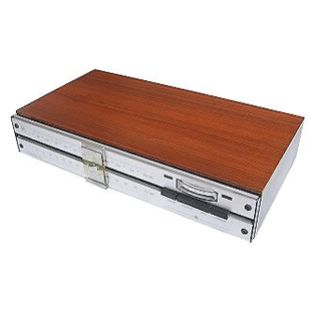BeoMaster 5000 Tuner

Manufactured: 1967 - 1972
Designer: Jacob Jensen
Colours: Rosewood, Teak
Highly selective and sensitive FM stereo tuner with low-distortion multiplex adaptor featuring a high degree of channel separation. It has a 4-section gang-tuned radio-frequency amplifier with separate oscillator, five-stage intermediate-frequency amplifier, automatic frequency control, and automatic stereo/mono switching.
Large tuning meter facilitates pin-point tuning and provides relative signal-strength indication. An automatic data-processing centre switches from mono to stereo when the signal-to-noise ratio permits stereo reception (and if the set is tuned to a stereo broadcast). Moreover, it automatically cuts out the signal if the field strength drops below the critical level - and between channels, during tuning. The automatic frequency control circuit also ensures that the set stays accurately tuned at all times. The remarkable sensitivity of the Beomaster 5000 is due to the use of multi-stage radio-frequency and intermediate-frequency amplifiers, and the large number of intermediate-frequency circuits provide knife-edge selectivity. An amply-dimensioned true slide-rule dial with station markers ensures easy and rapid tuning." - taken from the 1967 - 1968 Bang & Olufsen product catalogue
Bang & Olufsen's Beomaster 5000 FM tuner, Beolab 5000 amplifier and Beovox 2500 Cube loudspeakers were among the first product series designed by Jacob Jensen in 1967. The first was Beomaster 1000 in 1964.
The traditional style for tuning knobs was replaced by an exact measuring instrument akin to the slide rule which was considered an innovation in changing the future of radios and amplifiers. The interface, in its precision and simplicity, proved to give the user optimal functionality. This solution had never been seen before and laid the foundation for the future form language of B&O. Beomaster 5000 was an FM tuner, with elimination of static between stations and a built in 'data base' which automatically tuned in on stereo broadcasts.
Partner to Beomaster 5000 was Beolab 5000, an amplifier with a similarly-designed slide rule interface.
At the 1967 spring fair in Hanover, B&O received the IF award for Beomaster 5000, BeoLab 5000 and Beovox 2500 Cube for outstanding and user-friendly design.
BeoMaster 5000 Tuner Product Specifications
Types:
US 2013 (1967 - Dec 1973)
2005 (1967 - Dec 1972)
Tuning range 87 - 108 Mc/s
20 dB signal-to-noise ratio 0.8 µV
Useable sensitivity 1.5 µV
Limiting 1.5 µV
Signal-to-noise ratio 75 dB
Distortion 0.4 %
AM suppression 52 dB
Capture ratio 2 dB
IF bandwidth 300 kc/s
Detector bandwidth 1 Mc/s
Stereo crosstalk 40 dB
Connections: RCA or DIN socket for amplifier
DIN socket for tape recorder
Pilot and carrier suppression 50 dB
Frequency response: 20 c/s - 15 kc/s, stereo, mono +/- 2 dB
Channel difference, output +/- 2 dB
Aerial inputs
Output level for amplifier
Output level for tape recorder
4-stage gang-turned front-end with separate oscillator and mixer function
AFC (automatic frequency control)
Automatic stereo/mono switching level adjustable between 1 and 100 µV
Muting (removes inter-station hiss) Switching level adjustable for signal strengths between 0.5 and 40 µV
Precision tuning meter
Stereo indicator for visual identification af stereo broadcasting 25 tuned circuits, 22 transistors, 20 diodes
Related Products
- BeoGram 3000 Record Deck Type 5210
- BeoGram 3000 Record Deck Type 5211
- BeoLab 5000 Amplifier
- BeoCord 1500 De Luxe Reel to Reel Tape Deck
- BeoCord 1800 2&4-Track Reel to Reel Tape Deck
- BeoCord 2000 Deluxe K Reel to Reel Tape Deck
- BeoVox 5000 Passive Loudspeakers
- BeoVox 2500 "Cube" Tweeters
- SP8/9
Created: 30th November 2006
Modified: 2nd February 2007
Author Notes:




